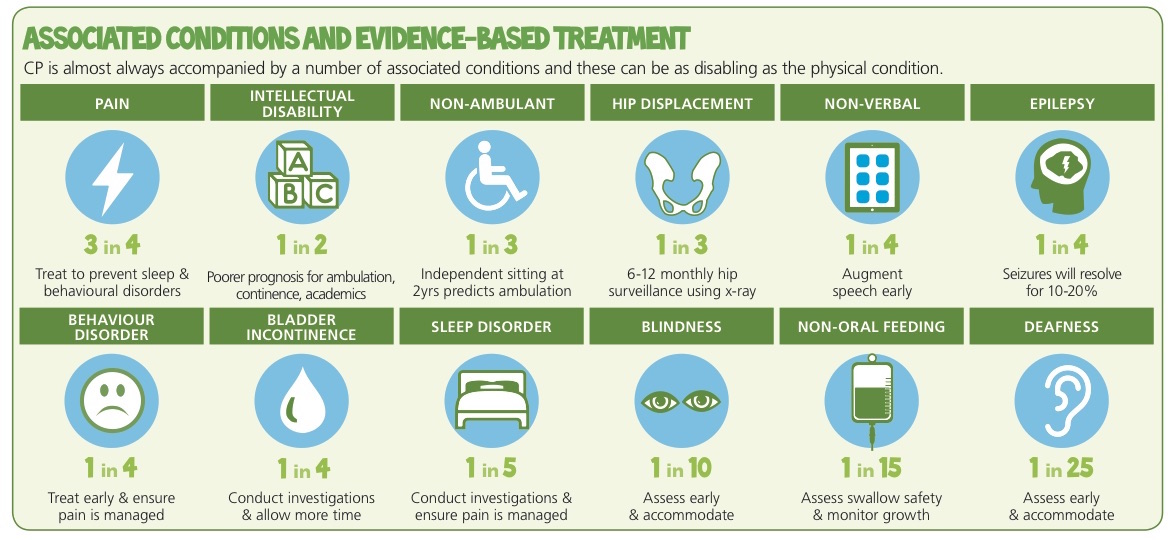Cerebral Palsy and Associated Conditions: Difference between revisions
No edit summary |
No edit summary |
||
| Line 1: | Line 1: | ||
== Introduction == | == Introduction == | ||
Children with Cerebral Palsy often have associated conditions, which are health conditions that a person has in addition to Cerebral Palsy that can have an affect on a childs child’s quality of life. Some of these conditions may be related related to Cerebral Palsy, while others are unrelated, but are commonly associated with Cerebral Palsy. | Children with Cerebral Palsy often have associated conditions, which are health conditions that a person has in addition to Cerebral Palsy that can have an affect on a childs child’s quality of life. Some of these conditions may be related related to Cerebral Palsy, while others are unrelated, but are commonly associated with Cerebral Palsy. | ||
[[Image:Assoc_Conditions.jpg|center]] | |||
== Learning Difficulties<br> == | == Learning Difficulties<br> == | ||
Revision as of 15:34, 13 August 2016
Introduction[edit | edit source]
Children with Cerebral Palsy often have associated conditions, which are health conditions that a person has in addition to Cerebral Palsy that can have an affect on a childs child’s quality of life. Some of these conditions may be related related to Cerebral Palsy, while others are unrelated, but are commonly associated with Cerebral Palsy.
Learning Difficulties
[edit | edit source]
Children with cerebral palsy may experience specific learning difficulties. These may include a short attention span, motor planning difficulties (organisation and sequencing), perceptual difficulties and language difficulties.
Intellectual Difficulties
[edit | edit source]
Children with cerebral palsy vary widely in their intellectual capabilities. Some will show the same abilities as other people, despite their physical difficulties. Others will have some degree of intellectual disability, ranging from mild to significant. Speech that is difficult to understand, saliva loss or the movements of children with cerebral palsy, may give the mistaken impression of an intellectual impairment.
Perceptual Difficulties[edit | edit source]
Perception is the making sense of information gained from the senses. This enables children to do things such as move around obstacles, judge size and shape of objects and understand how lines are connected to form letters. For those who experience these difficulties, their problems may not become apparent until school or preschool.
Communication / language difficulties
[edit | edit source]
Children with cerebral palsy may have difficulties with understanding and expressing ideas. They may require support to follow instructions, construct sentences, give specific information or tell stories that make sense. If a child is having any of these difficulties, it may have an effect on learning.
Speech difficulties
[edit | edit source]
Because the muscles of the mouth may be affected, some children may find talking difficult. For those with restricted speech, an alternative communication system may assist them (for example communication board, book or electronic device). Speech that is difficult to understand is not necessarily an indication of intellectual impairment.
Eating and Drinking Difficulties
[edit | edit source]
Cerebral palsy may affect the muscles that open and close the mouth and move the lips and the tongue. Some children may show difficulties in chewing and swallowing food and drink.
Saliva Loss[edit | edit source]
Due to poor muscle control some children with cerebral palsy may have varying degrees of saliva loss (dribbling). The dribbling may be more noticeable when they are concentrating on a fine motor task.
Vision
[edit | edit source]
Some children may have visual impairments. One of these may be: Strabismus (also known as ‘turned eye’ or ‘squint’) - One or both eyes are turned in or out and are prevented from working together. This may lead to double vision or focusing with one eye at a time.
Hearing
[edit | edit source]
Some children with Cerebral Palsy may have hearing loss.
Epilepsy
[edit | edit source]
If this problem is present, the doctor may aim to control the seizures by choosing medicine that suits the child. It may be necessary to change the medication several times before the seizures are controlled. Sometimes they cannot be controlled.
Other Associated Problems
[edit | edit source]
A systemic review was performed in order to compile information on the rates of co-occurring impairments, diseases, and functional limitations in children with cerebral palsy. Here is an overview of the results:
3 in 4 were in pain
1 in 2 had an intellectual disability
1 in 3 could not walk
1 in 3 had a hip displacement
1 in 4 could not talk
1 in 4 had epilepsy
1 in 4 had a behaviour disorder
1 in 4 had bladder control problems
1 in 5 had a sleep disorder
1 in 5 dribbled
1 in 10 were blind
1 in 15 were tube-fed
1 in 25 were deaf
You can read more about this review here.







